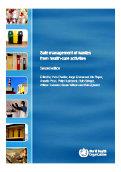
Medical waste
WHO defines medical waste as waste generated by health care activities, ranging from used needles and syringes to soiled dressings, body parts, diagnostic samples, blood, chemicals, pharmaceuticals, medical devices and radioactive materials.
Waste management is an essential part of health care. Poor management of health care waste exposes health care workers, waste handlers and the community to infections, toxic effects and injuries, and risks that pollute the environment.
Of the total amount of waste generated by health care activities, 15% is considered hazardous material that may be infectious, chemical or radioactive. In 2010, unsafe injections were responsible for as many as 33 800 new HIV infections, 1.7 million hepatitis B infections and 315 000 hepatitis C infections.
The management of health care waste requires increased attention and diligence to avoid adverse health outcomes associated with poor practices, including exposure to infectious agents and toxic substances. Government commitment and support is needed for universal, sustained and long-term improvement.
WHO developed the first global and comprehensive guidance document in 2014 - Safe management of wastes from health care activities. The guide addresses aspects such as regulatory framework, planning issues, waste minimization and recycling, handling, storage and transportation, treatment and disposal options, and training.
Technical links

